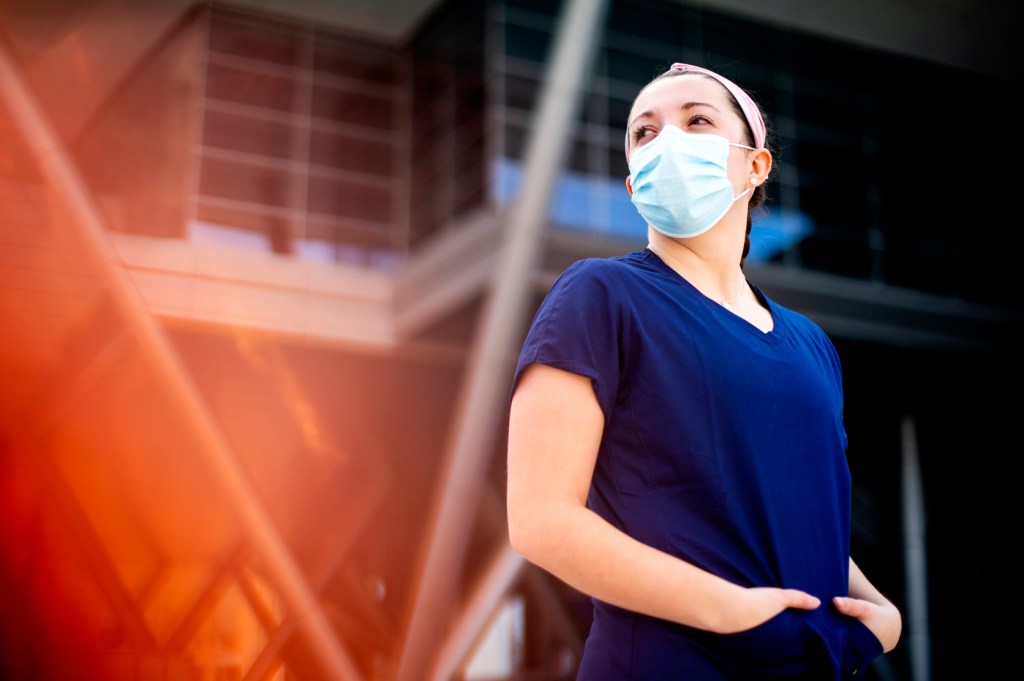Homeless populations have been hit hard by COVID-19. She’s stepping in to help.

Sanitize your hands. Put a pair of gloves on. Put on your gown. Put a second pair of gloves on. Put your mask on. Slide your face shield over your head. Finally, step into the patient area.
Sarah Calnan recites the steps in rapid-fire succession; they’re as familiar to her now as the back of her gloved hand.


Four days a week, Calnan—a certified nursing assistant and a student in Northeastern’s nursing program—drives from Hingham, Massachusetts, to the Boston Convention and Exhibition Center in the city. Someone takes her temperature as she walks into the building, and asks whether she’s shown any signs of COVID-19. When both checks come back clear, she puts on a mask, and walks through to a makeshift locker room of sorts.
The donning area, as it’s called, is a large sterile room, where Calnan and other healthcare professionals meticulously dress themselves in protective equipment before entering the convention center-turned-field hospital.

Since mid-April, Calnan has been working at the Boston Hope Medical Center, a respite shelter for people who are experiencing homelessness and have tested positive for SARS-CoV-2, the virus that causes the illness.
The medical center was created by city and state officials, and managed by medical providers in the city. But it is staffed by people such as Calnan, who saw a need and stepped up to fill it.

Calnan wearing a tyvek suit and N95 mask within the center. Photo courtesy of Sarah Calnan
Calnan was just finishing her first semester in Northeastern’s Accelerated Bachelor of Science in Nursing program when the disease started sweeping through the U.S. She’d been working part time at a restaurant while juggling classes and clinical rotations when suddenly, everything changed. The restaurant slimmed down its staff to accommodate only take-out business, Calnan’s courses moved online, and her clinical education paused. Then, she saw an ad online for Boston Hope.
“I had the time, and felt compelled to offer any help I could,” she says.
Because of the close quarters within shelters, homeless populations across the country have been hit hard by the disease—if people can’t isolate themselves, the virus can spread unabated. Shelters in Boston have been actively testing their residents to try to stay ahead of the spread of the virus.
“This is a population that’s so vulnerable to this disease,” Calnan says. “People are often at the mercy of the shelter [where they’re staying], and once they’ve tested positive, they often have no way to separate themselves.”
The patients at Boston Hope show either mild symptoms or they’re asymptomatic, Calnan says. More serious cases go directly to a hospital.
Calnan spends her days at Boston Hope intaking and triaging patients, and helping more senior healthcare professionals, she says. She takes patients’ vital signs—noting their blood pressure, temperature, rate of breathing, pulse, and oxygen saturation—and tracks any changes day to day. She talks to the patients, and if they have any physical complaints, such as a persistent cough, or concern about their blood pressure, Calnan ensures that the doctors on call are aware.
“The thing is, anyone could start to deteriorate at any point; we’re still trying to figure this out,” she says.
But for all her crucial medical work, Calnan finds the one-on-one time she gets to spend with patients among the most rewarding while she’s there. She’ll work on a puzzle, or play a round of the game Sorry! with patients, and in that moment, through all the protective layers she and others must wear, finds the humanity of her job once more.
“These moments where we’re just talking or having fun, and my patient doesn’t seem scared, those are moments that are really rewarding,” Calnan says. “I’m there, and I’m afraid of contracting the disease; they’re there, and they’re afraid because they already have it, but for a moment, we can forget about that and just be together.”
When it’s time to go home, Calnan goes through a 15-step doffing process, during which all the layers she so meticulously donned get peeled away with just as much caution. She drives home, where she carefully changes into fresh clothes in her family’s garage before stepping into the house, and, exhausted, gets ready to do it all over again the next day.
For media inquiries, please contact media@northeastern.edu.





